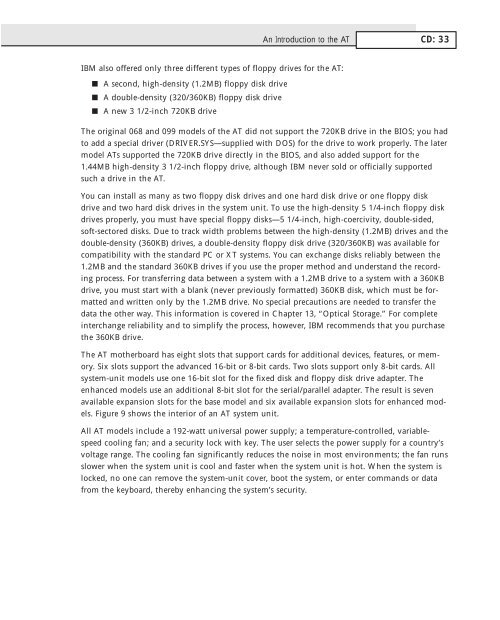Original PC Hardware Reference
Original PC Hardware Reference
Original PC Hardware Reference
Create successful ePaper yourself
Turn your PDF publications into a flip-book with our unique Google optimized e-Paper software.
IBM also offered only three different types of floppy drives for the AT:<br />
■ A second, high-density (1.2MB) floppy disk drive<br />
■ A double-density (320/360KB) floppy disk drive<br />
■ A new 3 1/2-inch 720KB drive<br />
An Introduction to the AT CD: 33<br />
The original 068 and 099 models of the AT did not support the 720KB drive in the BIOS; you had<br />
to add a special driver (DRIVER.SYS—supplied with DOS) for the drive to work properly. The later<br />
model ATs supported the 720KB drive directly in the BIOS, and also added support for the<br />
1.44MB high-density 3 1/2-inch floppy drive, although IBM never sold or officially supported<br />
such a drive in the AT.<br />
You can install as many as two floppy disk drives and one hard disk drive or one floppy disk<br />
drive and two hard disk drives in the system unit. To use the high-density 5 1/4-inch floppy disk<br />
drives properly, you must have special floppy disks—5 1/4-inch, high-coercivity, double-sided,<br />
soft-sectored disks. Due to track width problems between the high-density (1.2MB) drives and the<br />
double-density (360KB) drives, a double-density floppy disk drive (320/360KB) was available for<br />
compatibility with the standard <strong>PC</strong> or XT systems. You can exchange disks reliably between the<br />
1.2MB and the standard 360KB drives if you use the proper method and understand the recording<br />
process. For transferring data between a system with a 1.2MB drive to a system with a 360KB<br />
drive, you must start with a blank (never previously formatted) 360KB disk, which must be formatted<br />
and written only by the 1.2MB drive. No special precautions are needed to transfer the<br />
data the other way. This information is covered in Chapter 13, “Optical Storage.” For complete<br />
interchange reliability and to simplify the process, however, IBM recommends that you purchase<br />
the 360KB drive.<br />
The AT motherboard has eight slots that support cards for additional devices, features, or memory.<br />
Six slots support the advanced 16-bit or 8-bit cards. Two slots support only 8-bit cards. All<br />
system-unit models use one 16-bit slot for the fixed disk and floppy disk drive adapter. The<br />
enhanced models use an additional 8-bit slot for the serial/parallel adapter. The result is seven<br />
available expansion slots for the base model and six available expansion slots for enhanced models.<br />
Figure 9 shows the interior of an AT system unit.<br />
All AT models include a 192-watt universal power supply; a temperature-controlled, variablespeed<br />
cooling fan; and a security lock with key. The user selects the power supply for a country’s<br />
voltage range. The cooling fan significantly reduces the noise in most environments; the fan runs<br />
slower when the system unit is cool and faster when the system unit is hot. When the system is<br />
locked, no one can remove the system-unit cover, boot the system, or enter commands or data<br />
from the keyboard, thereby enhancing the system’s security.

















